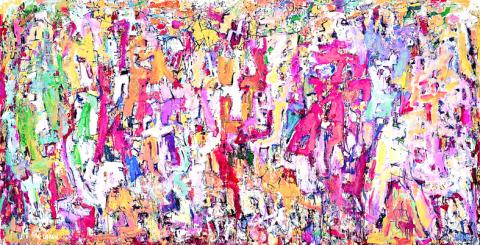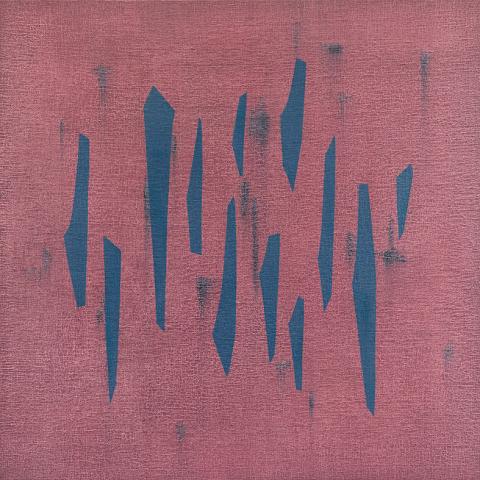An Older Sister’s Words, A Younger Sister’s Sketches (姊姊的話 妹妹的畫) is a solo show coordinated by Annie Yang for her sister, who suffers from multiple personality disorder. Born in Changhua County, the Yang sisters were close as children and both artistically gifted. After the emergence of her mental illness, the younger sister struggled with social interaction and took to drawing one picture every day: colorful, unusual depictions of people matched to short phrases that comment on her surroundings.
■ Cafe-Changee (延吉小屋), 55, Ln 106, Bade Rd Sec 3, Taipei City (台北市八德路三段106巷55號), tel: (02) 2577-8248. Open Tuesdays to Sundays from noon to 8pm
■ Until March 30

Photo courtesy of Tina Keng Gallery
The Seven Beds (七張床) are simple graphics based on seven beds Wu Tung-lung (吳東龍) slept on in New York City. Wu left for Brooklyn last year to work at the International Studio and Curatorial Program, as part of the Ministry of Culture’s International Artist Residency Exchange Program. While overseas, Wu lived with friends and rented rooms, hopping from one sleeping arrangement to another. “There was a mattress that has already lost its springiness, rooms that were noisy and restless, old yellow sheets and moldy pillows, a couch with a broken leg, and an attic up on a layer sandwiched with wooden boards,” writes Wu in the gallery notes. Each work at the exhibition — a basic image with Wu’s distinctive color treatment and minimalism of expression — represents a different bed, as well a demographic of New York’s chaotic humanity that may have slept in it before.
■ Project Fulfill Art Space (就在藝術空間), 2, Alley 45, Ln 147, Xinyi Rd Sec 3, Taipei City (台北市信義路三段147巷45弄2號), tel: (02) 2707-6942. Open Tuesdays to Sundays from 1pm to 6pm
■ Opening reception tomorrow at 4pm. Until April 27

Photo courtesy of Project Fulfill Art Space
The Art of George Chann (陳蔭羆藝術展) is a retrospective exhibition on a Chinese-American artist who became a fixture of modern art in California. Born in 1913 in Canton, China, George Chann (陳蔭羆) immigrated to the US as a child and made a name painting impressionist portraits of Asians, blacks and other American minorities. Chann’s current exhibition presents this early portraiture, as well as figurative landscapes and the abstract expressionist paintings of his later years. In the 1950s, Chann developed a characteristic style of abstract painting, in which Chinese calligraphic characters were pressed and scratched until they broke apart on the canvas and became indistinguishable.
■ Tina Keng Gallery (耿畫廊), 15, Ln 548, Ruiguang Rd, Taipei City (台北市瑞光路548巷15號), tel: (02) 2659-0798. Open Tuesdays to Sundays from 10am to 7pm
■ Until April 20
Cloacinae: Goddess of the Sewer (克蘿亞琴娜:下水道的守護女神) compiles recent work by French artist Serge Onnen including wallpaper, a light installation, animation and paintings. His centerpiece is the short film Cloacinae, named after the Roman goddess of the sewers. Animated by shadow puppets, the film is a trip underground via sewers, the negative space that makes modern standards of living possible. Onnen joins Robin Erik Ruizendaal, art director of Taiyuan Puppet Theatre Company, in a talk on the art of shadow puppetry this Sunday at 2:30pm.
■ MOCA Studio Underground (地下實驗), Zhongshan Metro Mall, near Exit R9 (捷運中山地下街,近R9出口), tel: (02) 2552-3721. Free admission
■ Until March 30
The Festival of the Callalily (竹子湖海芋季) is an annual floral art exhibition hosted by small farms that offer bouquets, live music and guided tours of the nearby Bamboo Lake (竹子湖).
■ Multiple venues at Yangmingshan National Park (陽明山國家公園) in Taipei City. For full list of locations and visiting hours, see www.callalily.com.tw
■ Until April 27

June 2 to June 8 Taiwan’s woodcutters believe that if they see even one speck of red in their cooked rice, no matter how small, an accident is going to happen. Peng Chin-tian (彭錦田) swears that this has proven to be true at every stop during his decades-long career in the logging industry. Along with mining, timber harvesting was once considered the most dangerous profession in Taiwan. Not only were mishaps common during all stages of processing, it was difficult to transport the injured to get medical treatment. Many died during the arduous journey. Peng recounts some of his accidents in

“Why does Taiwan identity decline?”a group of researchers lead by University of Nevada political scientist Austin Wang (王宏恩) asked in a recent paper. After all, it is not difficult to explain the rise in Taiwanese identity after the early 1990s. But no model predicted its decline during the 2016-2018 period, they say. After testing various alternative explanations, Wang et al argue that the fall-off in Taiwanese identity during that period is related to voter hedging based on the performance of the Democratic Progressive Party (DPP). Since the DPP is perceived as the guardian of Taiwan identity, when it performs well,

A short walk beneath the dense Amazon canopy, the forest abruptly opens up. Fallen logs are rotting, the trees grow sparser and the temperature rises in places sunlight hits the ground. This is what 24 years of severe drought looks like in the world’s largest rainforest. But this patch of degraded forest, about the size of a soccer field, is a scientific experiment. Launched in 2000 by Brazilian and British scientists, Esecaflor — short for “Forest Drought Study Project” in Portuguese — set out to simulate a future in which the changing climate could deplete the Amazon of rainfall. It is

Artifacts found at archeological sites in France and Spain along the Bay of Biscay shoreline show that humans have been crafting tools from whale bones since more than 20,000 years ago, illustrating anew the resourcefulness of prehistoric people. The tools, primarily hunting implements such as projectile points, were fashioned from the bones of at least five species of large whales, the researchers said. Bones from sperm whales were the most abundant, followed by fin whales, gray whales, right or bowhead whales — two species indistinguishable with the analytical method used in the study — and blue whales. With seafaring capabilities by humans